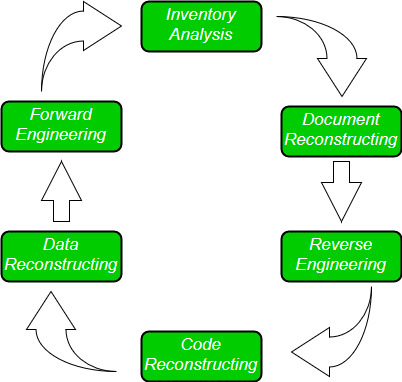Software Re-Engineering
Last Updated :
15 Dec, 2022
Software Re-Engineering is the examination and alteration of a system to reconstitute it in a new form. The principle of Re-Engineering when applied to the software development process is called software re-engineering. It positively affects software cost, quality, customer service, and delivery speed. In Software Re-engineering, we are improving the software to make it more efficient and effective.
It is a process where the software’s design is changed and the source code is created from scratch. Sometimes software engineers notice that certain software product components need more upkeep than other components, necessitating their re-engineering.
The re-Engineering procedure requires the following steps
- Decide which components of the software we want to re-engineer. Is it the complete software or just some components of the software?
- Do Reverse Engineering to learn about existing software functionalities.
- Perform restructuring of source code if needed for example modifying functional-Oriented programs in Object-Oriented programs
- Perform restructuring of data if required
- Use Forward Engineering ideas to generate re-engineered software
The need for software Re-engineering: Software re-engineering is an economical process for software development and quality enhancement of the product. This process enables us to identify the useless consumption of deployed resources and the constraints that are restricting the development process so that the development process could be made easier and cost-effective (time, financial, direct advantage, optimize the code, indirect benefits, etc.) and maintainable. The software reengineering is necessary for having-
a) Boost up productivity: Software reengineering increase productivity by optimizing the code and database so that processing gets faster.
b) Processes in continuity: The functionality of older software products can be still used while the testing or development of software.
c) Improvement opportunity: Meanwhile the process of software reengineering, not only software qualities, features, and functionality but also your skills are refined, and new ideas hit your mind. This makes the developer’s mind accustomed to capturing new opportunities so that more and more new features can be developed.
d) Reduction in risks: Instead of developing the software product from scratch or from the beginning stage, developers develop the product from its existing stage to enhance some specific features brought in concern by stakeholders or its users. Such kind of practice reduces the chances of fault fallibility.
e) Saves time: As stated above, the product is developed from the existing stage rather than the beginning stage, so the time consumed in software engineering is lesser.
f) Optimization: This process refines the system features, and functionalities and reduces the complexity of the product by consistent optimization as maximum as possible.
Re-Engineering cost factors:
- The quality of the software is to be re-engineered.
- The tool support availability for engineering.
- The extent of the data conversion is required.
- The availability of expert staff for Re-engineering.

Software Re-Engineering Activities:
1. Inventory Analysis:
Every software organization should have an inventory of all the applications.
- Inventory can be nothing more than a spreadsheet model containing information that provides a detailed description of every active application.
- By sorting this information according to business criticality, longevity, current maintainability, and other local important criteria, candidates for re-engineering appear.
- The resource can then be allocated to a candidate application for re-engineering work.
2. Document reconstructing:
Documentation of a system either explains how it operates or how to use it.
- Documentation must be updated.
- It may not be necessary to fully document an application.
- The system is business-critical and must be fully re-documented.
3. Reverse Engineering:
Reverse engineering is a process of design recovery. Reverse engineering tools extract data and architectural and procedural design information from an existing program.
4. Code Reconstructing:
- To accomplish code reconstruction, the source code is analyzed using a reconstructing tool. Violations of structured programming construct are noted and code is then reconstructed.
- The resultant restructured code is reviewed and tested to ensure that no anomalies have been introduced.
5. Data Restructuring:
- Data restructuring begins with a reverse engineering activity.
- The current data architecture is dissected, and the necessary data models are defined.
- Data objects and attributes are identified, and existing data structures are reviewed for quality.
6. Forward Engineering:
Forward Engineering also called renovation or reclamation not only recovers design information from existing software but uses this information to alter or reconstitute the existing system to improve its overall quality.
Like Article
Suggest improvement
Share your thoughts in the comments
Please Login to comment...